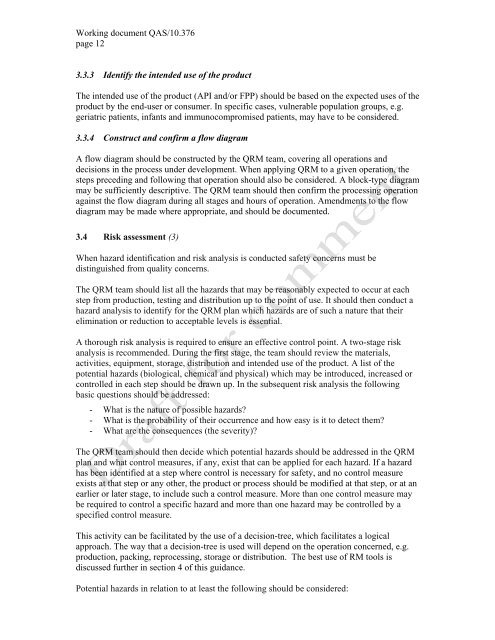who guideline on quality risk management - World Health ...
who guideline on quality risk management - World Health ...
who guideline on quality risk management - World Health ...
Create successful ePaper yourself
Turn your PDF publications into a flip-book with our unique Google optimized e-Paper software.
Working document QAS/10.376<br />
page 12<br />
3.3.3 Identify the intended use of the product<br />
The intended use of the product (API and/or FPP) should be based <strong>on</strong> the expected uses of the<br />
product by the end-user or c<strong>on</strong>sumer. In specific cases, vulnerable populati<strong>on</strong> groups, e.g.<br />
geriatric patients, infants and immunocompromised patients, may have to be c<strong>on</strong>sidered.<br />
3.3.4 C<strong>on</strong>struct and c<strong>on</strong>firm a flow diagram<br />
A flow diagram should be c<strong>on</strong>structed by the QRM team, covering all operati<strong>on</strong>s and<br />
decisi<strong>on</strong>s in the process under development. When applying QRM to a given operati<strong>on</strong>, the<br />
steps preceding and following that operati<strong>on</strong> should also be c<strong>on</strong>sidered. A block-type diagram<br />
may be sufficiently descriptive. The QRM team should then c<strong>on</strong>firm the processing operati<strong>on</strong><br />
against the flow diagram during all stages and hours of operati<strong>on</strong>. Amendments to the flow<br />
diagram may be made where appropriate, and should be documented.<br />
3.4 Risk assessment (3)<br />
When hazard identificati<strong>on</strong> and <strong>risk</strong> analysis is c<strong>on</strong>ducted safety c<strong>on</strong>cerns must be<br />
distinguished from <strong>quality</strong> c<strong>on</strong>cerns.<br />
The QRM team should list all the hazards that may be reas<strong>on</strong>ably expected to occur at each<br />
step from producti<strong>on</strong>, testing and distributi<strong>on</strong> up to the point of use. It should then c<strong>on</strong>duct a<br />
hazard analysis to identify for the QRM plan which hazards are of such a nature that their<br />
eliminati<strong>on</strong> or reducti<strong>on</strong> to acceptable levels is essential.<br />
A thorough <strong>risk</strong> analysis is required to ensure an effective c<strong>on</strong>trol point. A two-stage <strong>risk</strong><br />
analysis is recommended. During the first stage, the team should review the materials,<br />
activities, equipment, storage, distributi<strong>on</strong> and intended use of the product. A list of the<br />
potential hazards (biological, chemical and physical) which may be introduced, increased or<br />
c<strong>on</strong>trolled in each step should be drawn up. In the subsequent <strong>risk</strong> analysis the following<br />
basic questi<strong>on</strong>s should be addressed:<br />
- What is the nature of possible hazards?<br />
- What is the probability of their occurrence and how easy is it to detect them?<br />
- What are the c<strong>on</strong>sequences (the severity)?<br />
The QRM team should then decide which potential hazards should be addressed in the QRM<br />
plan and what c<strong>on</strong>trol measures, if any, exist that can be applied for each hazard. If a hazard<br />
has been identified at a step where c<strong>on</strong>trol is necessary for safety, and no c<strong>on</strong>trol measure<br />
exists at that step or any other, the product or process should be modified at that step, or at an<br />
earlier or later stage, to include such a c<strong>on</strong>trol measure. More than <strong>on</strong>e c<strong>on</strong>trol measure may<br />
be required to c<strong>on</strong>trol a specific hazard and more than <strong>on</strong>e hazard may be c<strong>on</strong>trolled by a<br />
specified c<strong>on</strong>trol measure.<br />
This activity can be facilitated by the use of a decisi<strong>on</strong>-tree, which facilitates a logical<br />
approach. The way that a decisi<strong>on</strong>-tree is used will depend <strong>on</strong> the operati<strong>on</strong> c<strong>on</strong>cerned, e.g.<br />
producti<strong>on</strong>, packing, reprocessing, storage or distributi<strong>on</strong>. The best use of RM tools is<br />
discussed further in secti<strong>on</strong> 4 of this guidance.<br />
Potential hazards in relati<strong>on</strong> to at least the following should be c<strong>on</strong>sidered:

















